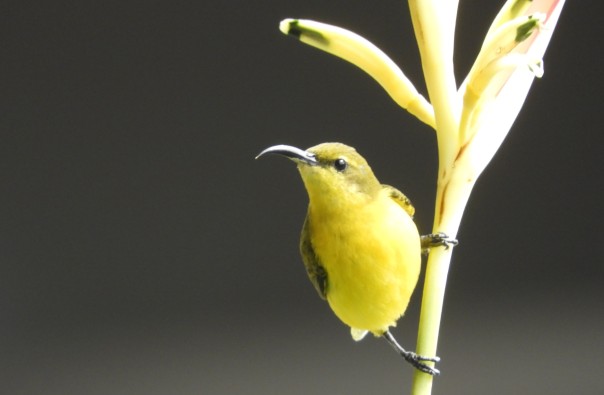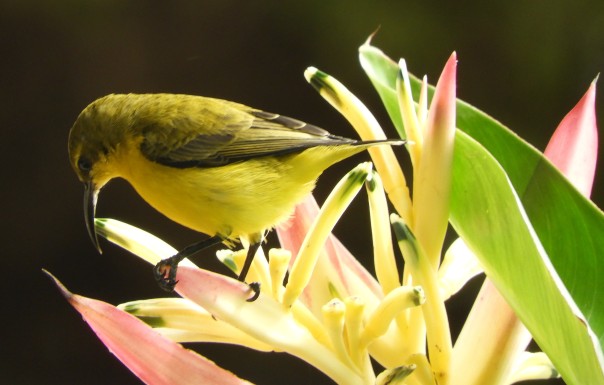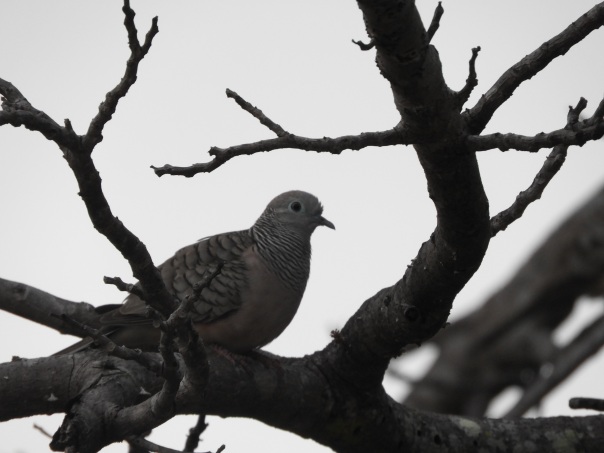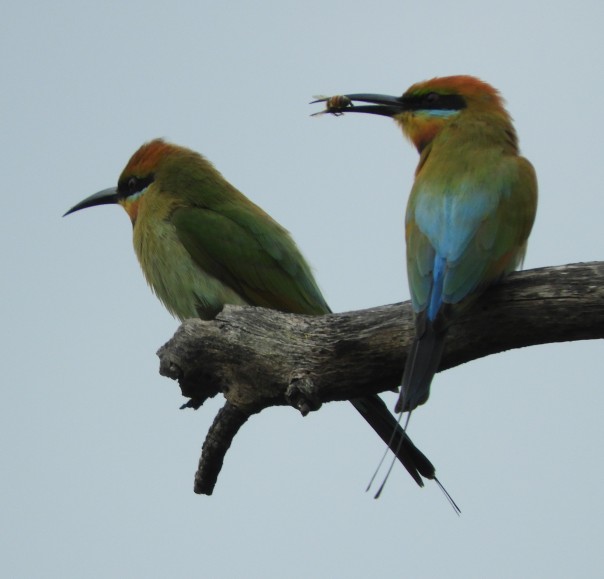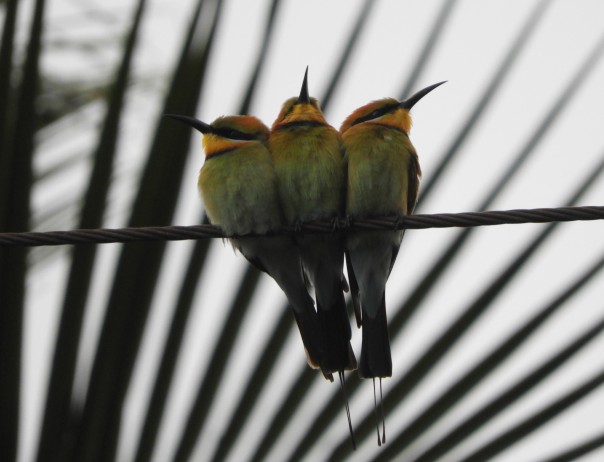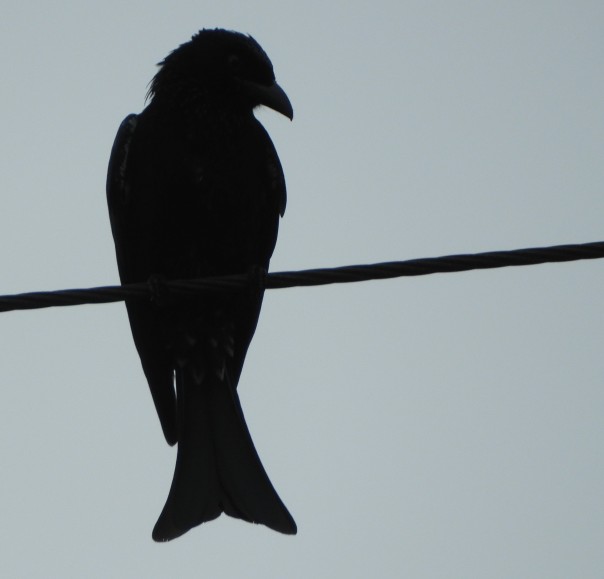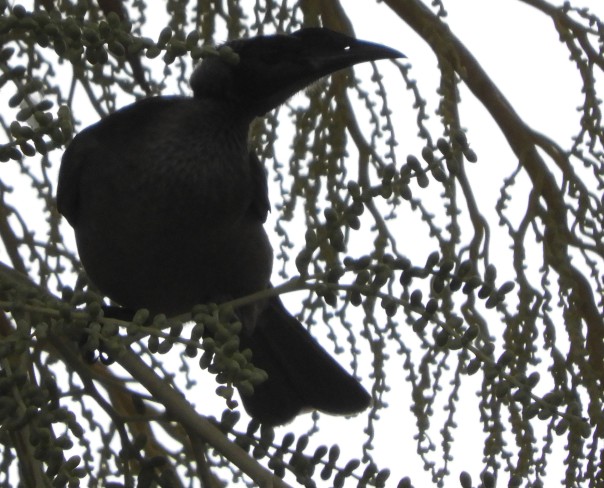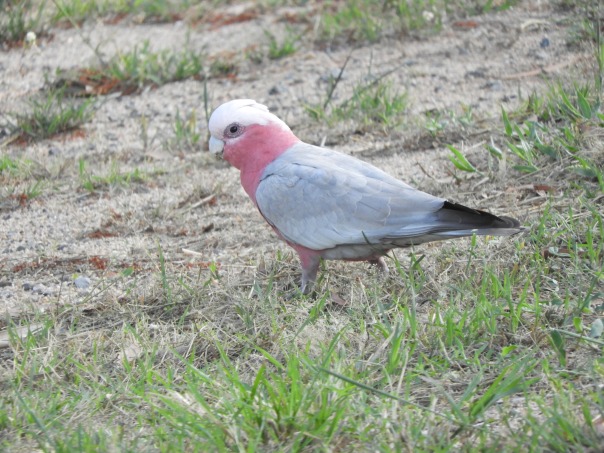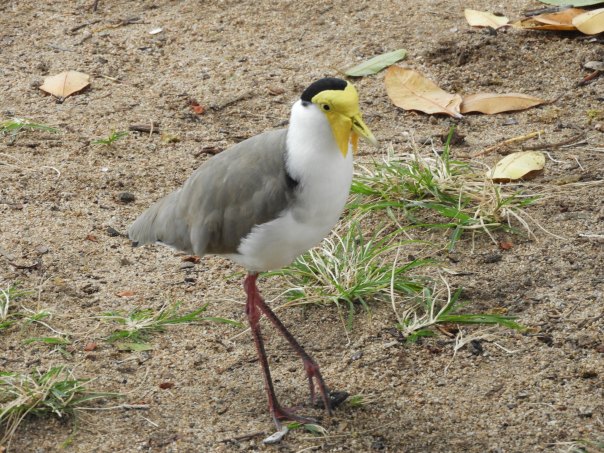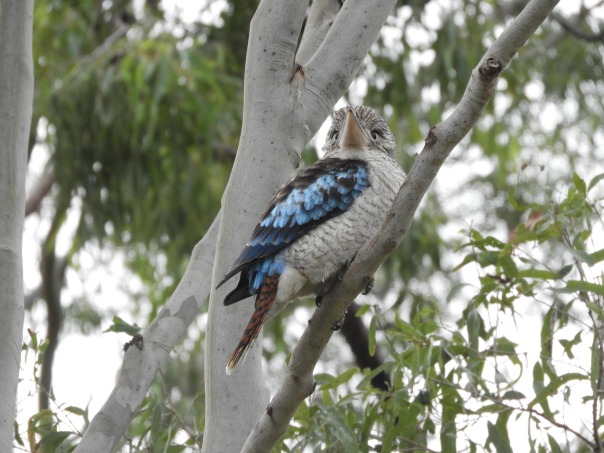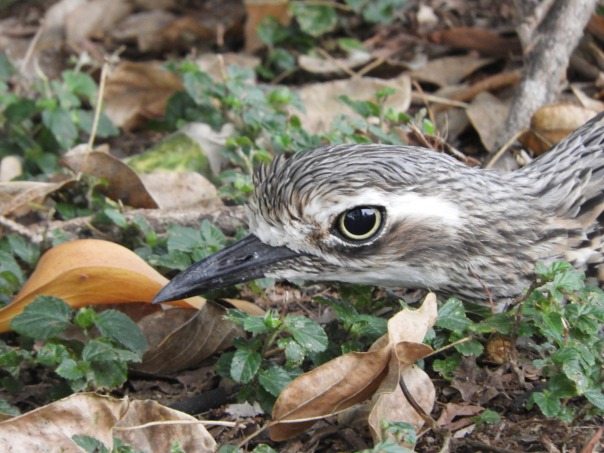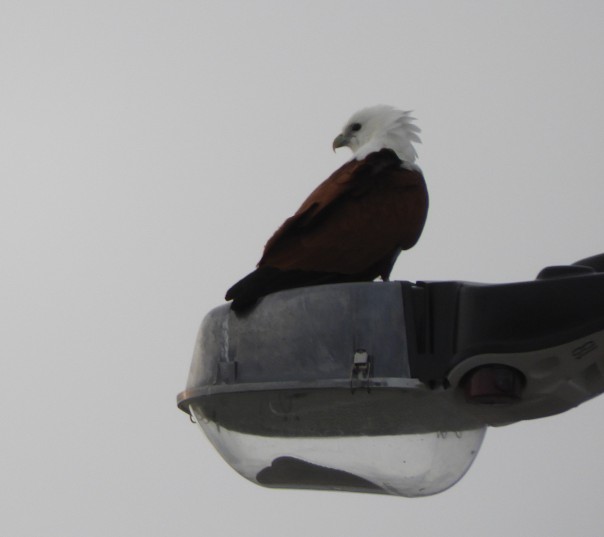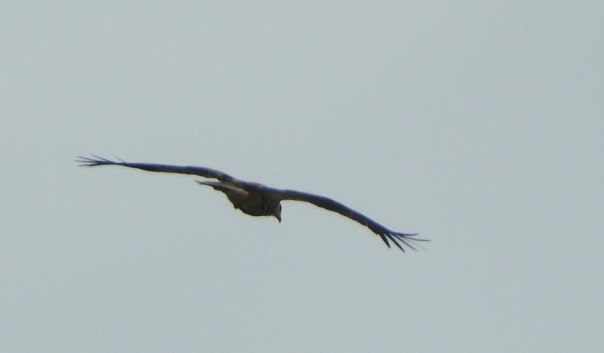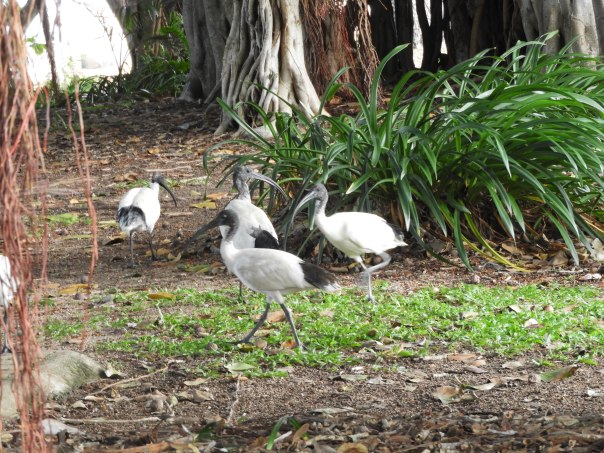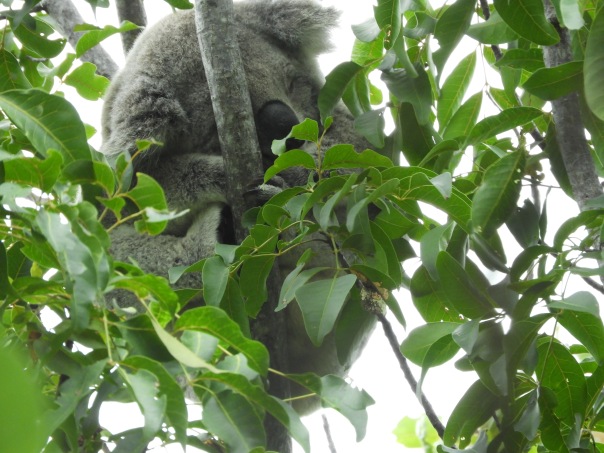Category Archives: Friarbird
Noisy Friarbird reminds me of stretcher bearers in Bedknobs and Broomsticks
I have a childhood memory of a movie (I think it was Bedknobs and Broomsticks) where the vultures were the stretcher bearers on the sidelines of a sports match. Each time someone was injured, the birds would straighten up and look excited, then hunch down again dejectedly when the person didn’t need their attention.
This Noisy Friarbird reminds me of those cartoon stretcher bearers!

Common name: Noisy Friarbird
Scientific name: Philemon corniculatus
Approximate length: 30-35 cm
Date spotted: 12 September 2025 (spring)
Location: Denman, NSW, Australia: 32°23’33.7″S 150°41’00.4″E
More Noisy Friarbirds in Sydney’s Northern Beaches
Over the last couple of weeks, I’ve seen and heard several Noisy Friarbirds at Manly Dam in Sydney’s Northern Beaches. The birds seem to have moved in for the long haul. It’s exciting — I’ve only seen these birds further north and west before now.
Today I managed to actually get some images of the birds in a video, as well as their weird calls:
In the video, most of the noise is made by the friarbirds, but there are Rainbow Lorikeets chirping throughout, and the occasional Little Wattlebird too.
You can see more pictures of friarbirds in my other posts, taken in other areas of Australia.
Common name: Noisy Friarbird
Scientific name: Philemon corniculatus
Approximate length: 30-35 cm
Date spotted: 2 April 2025 (autumn)
Location: Manly Dam Reserve, New South Wales, Australia: 33°46’43.4″S 151°14’52.8″E
Noisy Friarbirds at Manly Dam!
I was excited to hear Noisy Friarbirds at Manly Dam park in Sydney’s Northern Beaches. I haven’t seen these birds in the area before — they’re more common further north and west.
Over the past couple of weeks, I’ve heard the unforgettable sounds that these birds make. Today I managed to take some photos. In the video, you can hear the odd sounds made by the Noisy Friarbirds amongst other bird calls, but you don’t actually see the friarbirds. They’re very hard to spot.
The first bird sound in the video is the chirping of Rainbow Lorikeets. The laugh-like cackle and chatter of the Noisy Friarbirds begins soon after the start, at about 0:02. The lorikeets continue chirping throughout. In the background is the cackle of some Little Wattlebirds, which is similar to the friarbirds’ call but less varied in tone and style.
I did manage to snap a few photos of two friarbirds, though they’re quite blurry. This photo shows one of the friarbirds perched briefly out in the open:

Another friarbird was having an altercation with a Rainbow Lorikeet. The friarbird was the one to cede ground:

You can see some better pictures of friarbirds in my other posts, taken in other areas of Australia.
Common name: Noisy Friarbird
Scientific name: Philemon corniculatus
Approximate length: 30-35 cm
Date spotted: 26 March 2025 (summer)
Location: Manly Dam Reserve, New South Wales, Australia: 33°46’42.5″S 151°14’54.3″E
Noisy Friarbird feeding on Grevillea
I recently visited The Gap in Brisbane, Queensland. Every morning, as the sun came up, Noisy Friarbirds visited the flowering Grevilleas outside our window.
For the most part, the Noisy Friarbirds did live up to their name: they were noisy. Funnily enough, though, there’s not much Noisy Friarbird noise in the above video. I did take another video in the same location, of a Pale-headed Rosella this time. And, again funnily enough, in that video you don’t hear the Rosella but you do hear the Noisy Friarbirds (and other birds) in the background.
Noisy Friarbirds aren’t the prettiest of birds. Their body and wings are attractive in a quiet way, but the head looks as if it belongs on a dinosaur! The video and this photo give a nice view of the bump at the top of the bird’s beak, the bare skin and exposed ear, and that red eye:

Common name: Noisy Friarbird
Scientific name: Philemon corniculatus
Approximate length: 30-35 cm
Date spotted: 6 July 2024 (winter)
Location: The Gap, Brisbane, Queensland (approximate map reference)
Yellow-throated Miners see off a Noisy Friarbird
At first, I thought these birds were Noisy Miners, which are very common on the east coast of Australia where I live. However, we were out west at Mungo National Park, and the birds were Yellow-throated Miners.
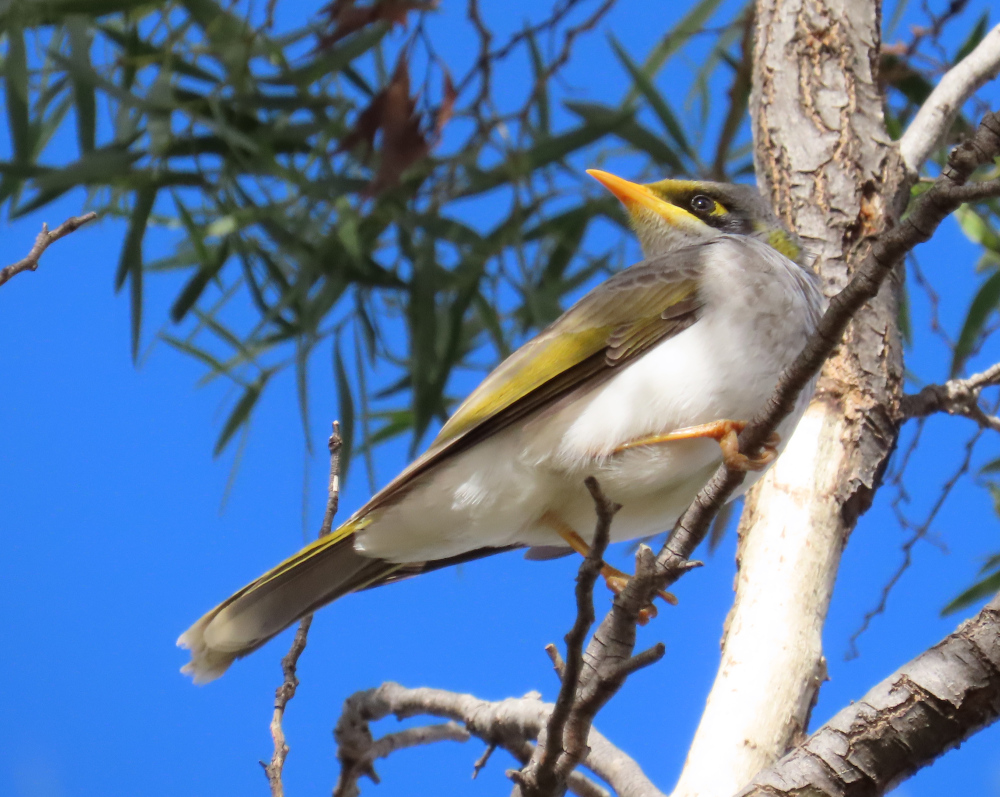
Common name: Yellow-throated Miner
Scientific name: Manorina favigula
Approximate length: 26-28 cm
Date spotted: 20-21 May 2024 (autumn)
Location: Mungo Lodge, Mungo National Park, New South Wales, Australia: 33°44’31.4″S 143°00’06.1″E
As you’d expect from the name, this bird has more yellow around its face and head than does the Noisy Miner. Here’s a Noisy Miner for comparison:

Just like their noisy cousins, it seems that the Yellow-throated Miners are territorial and fear nothing. These two were seeing off a Noisy Friarbird:
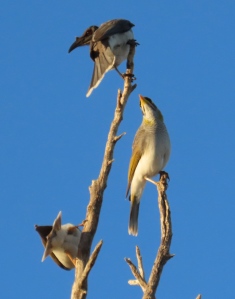
I have better pictures of Noisy Friarbirds in another post.
Second sighting of a Noisy Friarbird
This is only the second time I’ve seen a Noisy Friarbird. We’d stopped at a picnic area in the Blue Mountains for a quick snack and a swallow of coffee from our thermos. I noticed this rather unprepossessing bird peering at me from a Banksia tree:
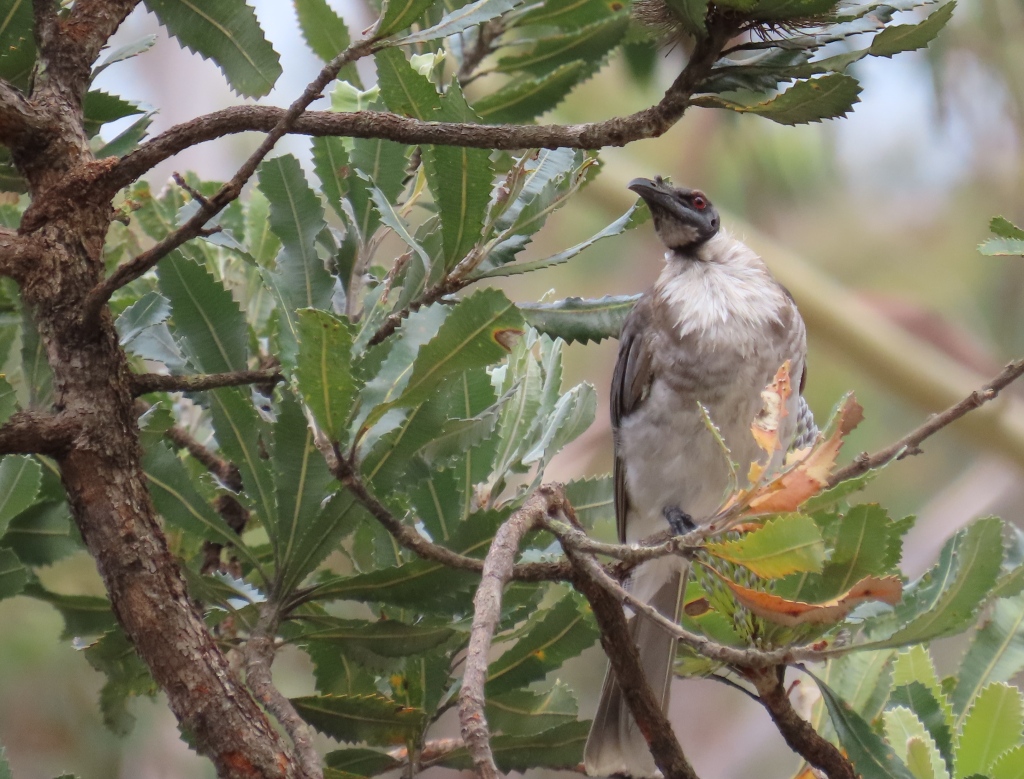
The bird was supping the nectar of the Banksia flowers, while checking for danger from above or below at regular intervals.
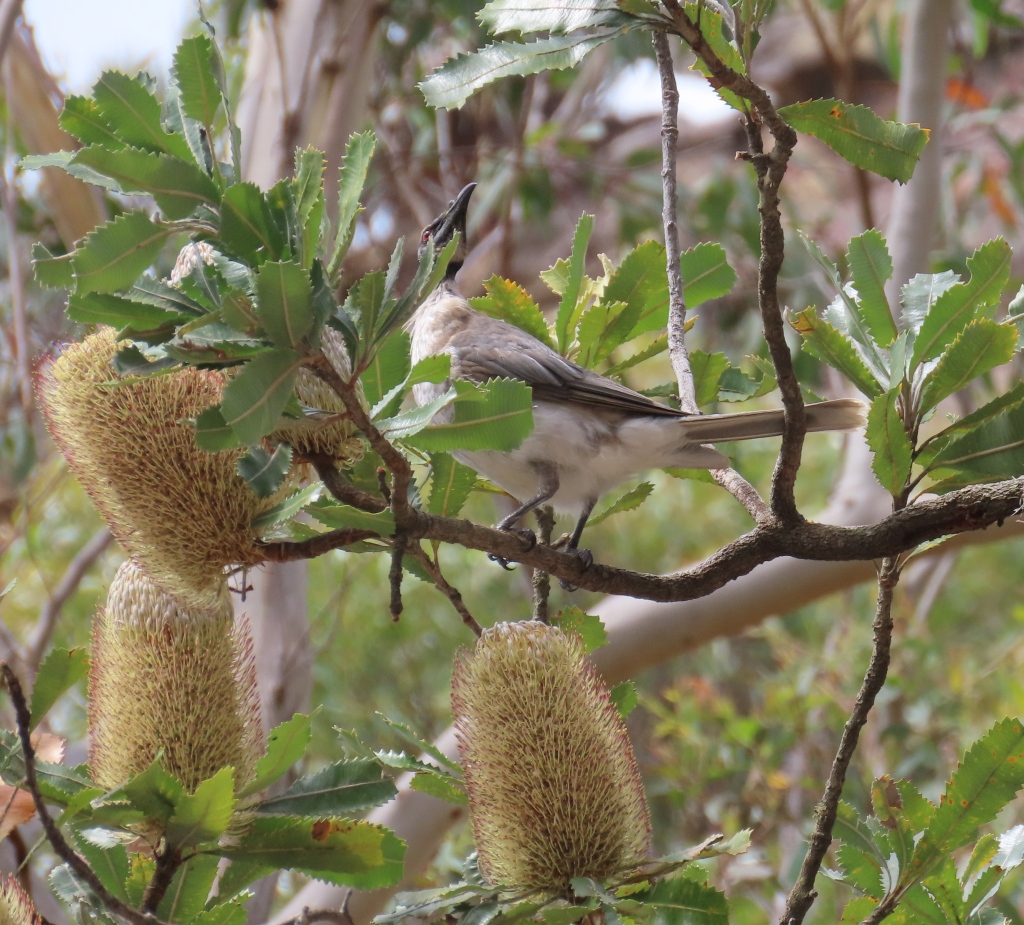
Noisy Friarbirds have a weird bump at the top of their beaks. It’s not visible in the photos, but you can see it in the video below, when the bird turns its head. The video shows the bird moving from branch to branch, pushing its beak into the flower heads. It’s probably taking insects from between the sticky tepals that make up the flower head. At one stage, I saw the bird grab a passing insect from the air too.
Common name: Noisy Friarbird
Scientific name: Philemon corniculatus
Approximate length: 30-35 cm
Date spotted: 20 January 2024 (summer)
Location: Pierces Pass Picnic Area, Blue Mountains, New South Wales, Australia: 33°34’13.2″S 150°20’17.0″E
Noisy Friarbird on nest at Coxs River
Off the beaten track for a day, I was delighted to see a Noisy Friarbird. Even more delightful was the fact that the bird was one of two taking turns to look after a nest:
The video shows one of the birds on the nest. It looks like there might be a youngster already hatched, because the bird seems to be passing something down into the nest (food?) and taking something else out (excrement?). At the end of the video, I panned out to show the lovely setting that the birds have chosen for their nest. It’s above Coxs River, with high trees and flowing water all round.
This is the first time I’ve seen a Noisy Friarbird. Indeed, it’s only the second friarbird that I’ve ever seen — the first was a Helmeted Friarbird up in North Queensland.
The nest is quite large and deep. It’s made of leaves, bark, and grass. Evidently the birds bind it together with spiderweb. Here’s a picture of one of the two birds sitting on the nest:
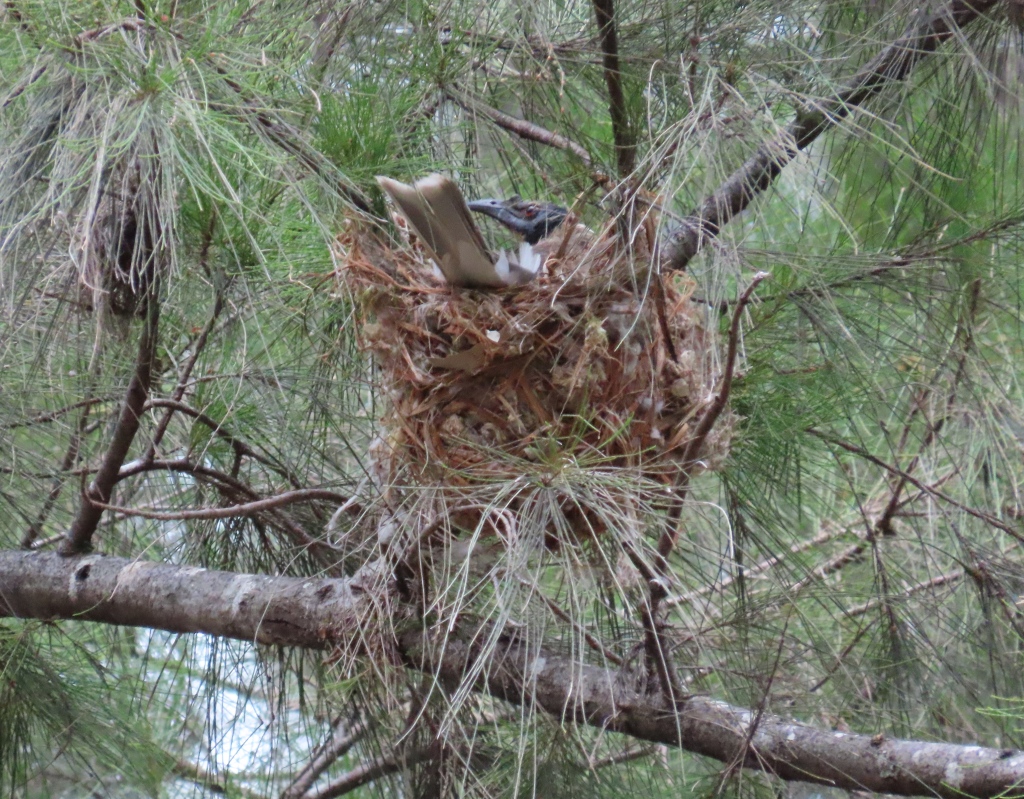
Noisy Friarbirds have a distinctive, slightly scary head: it’s bare of feathers, so that it looks a bit like a long black skull. Then there’s the large beak, with a knob on top. Not the prettiest of faces. The rest of the bird is quite pretty though, with creamy dappled white feathers below and soft browns and greys above, finished off with a white-tipped tail.
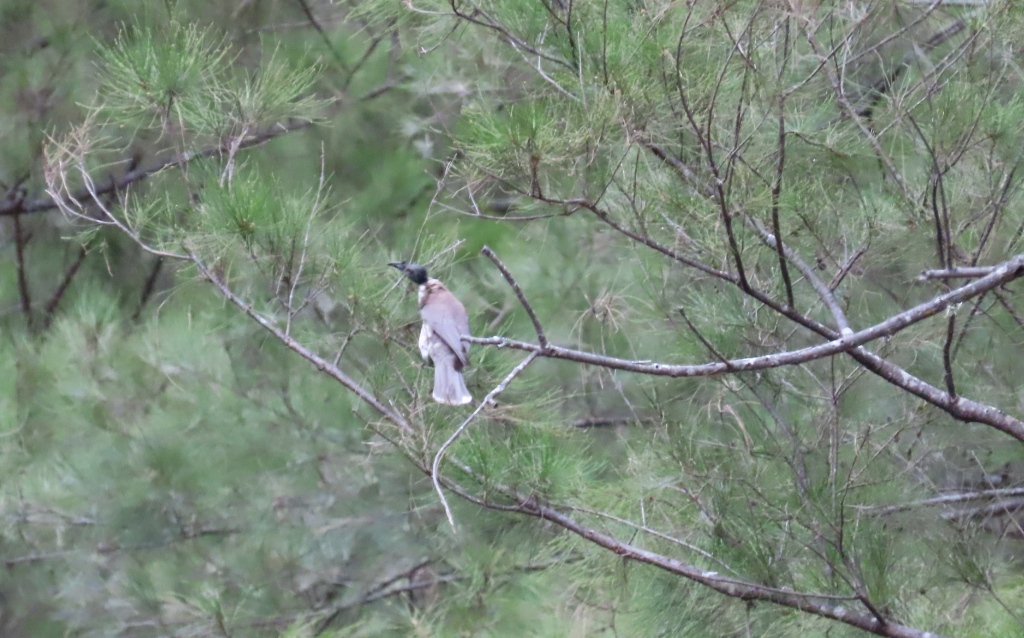
A few times, the birds would dive down steeply and fly horizontally just above the water. I think they were probably grabbing dragonflies and other insects as a tasty morsel:

This bird has something in its beak:

Common name: Noisy Friarbird
Scientific name: Philemon corniculatus
Approximate length: 30-35 cm
Date spotted: 23 December 2022 (summer)
Location: Coxs River Campground, Ganbenang, New South Wales, Australia: 33°44’35.1″S 150°10’45.1″E
Coxs River Campground is accessible only by four wheel drive. It’s a beautiful, restful spot, though it can get quite busy at times:

Birds on Magnetic Island
Last week I spent three days on Magnetic Island in North Queensland. Magnetic Island is a small island just offshore from Townsville. That’s approximately 2,000 km north of Sydney. The ferry ride from the mainland takes twenty minutes on the foot-passengers ferry, or forty minutes on the vehicle ferry. The island is a relaxing, lovely place to be.
Although I was on Magnetic Island for only a short while (two full days plus one evening and one morning) I encountered quite a few birds. Here are 16 of them, in rough order of size from small to large.
Yellow-bellied Sunbird
Scientific name: Nectarinia jugularis | Approximate length: 10-12 cm
This is a female Yellow-bellied Sunbird, spotted at Picnic Bay on Magnetic Island:
The beak of the Yellow-bellied Sunbird is long and curved, adapted for feeding from flowers:
White-breasted Woodswallow
Scientific name: Artamus leucorynchus | Approximate length: 16-18 cm
Three White-breasted Woodswallows clumping together. It was a chilly morning (well, chilly for the tropics, that is) so I guess they were sharing body heat:
Peaceful Dove
Scientific name: Geopelia placida (striata) | Approximate length: 20-24 cm
The Peaceful Dove is a small dove with an apricot tinge to its feathers. It has a soft, pleasant call as you can hear towards the end of this video:
Here’s a still shot of the same bird:
Rainbow Bee-eater
Scientific name: Merops ornatus | Approximate length: 23-27 cm
Given the name of this bird, I was particularly excited to snap one actually eating a bee!
Here’s a bird in the act of catching a bug:
This trio of bee-eaters clumped cosily in the chilly air of the early morning. Even a tropical island can feel cold to inhabitants used to the warmer summer weather:
Rainbow Lorikeet
Scientific name: Trichoglossus haematodus | Approximate length: 26-31 cm
These colourful parrots are extremely noisy, especially when you have a tree full of them:
Spangled Drongo
Scientific name: Dicrurus bracteatus | Approximate length: 28-32 cm
Drongo – what a cute name! Yet in Australia if someone calls you a “Drongo” you want to look closely at them, as it’s a bit of an insult. It means they think you’re not all that bright.
This is a female Spangled Drongo, I think, as its eyes are brown whereas the male has red eyes:
It’s easy to confuse these birds with crows and ravens. In fact, I heard Australian Ravens calling on the island, but didn’t get a photo of one.
The next photo is a pretty much a silhouette, but it shows off the Spangled Drongo’s forked tail:
Helmeted Friarbird
Scientific name: Philemon buceroides | Approximate length: 32-37 cm
This Helmeted Friarbird sat quietly on a branch listening to the birds all round. When it tilts its head you can see the odd-shaped knob on top of its beak:
Here’s another peering through the foliage:
Galah
Scientific name: Cacatua roseicapilla | Approximate length: 38 cm
Galahs are pretty pink and grey parrots. Australians sometimes call someone a “silly galah”, which I think is a slightly more affectionate term than “drongo”! I’ve seen Galahs in the Sydney area as well as up here on Magnetic Island. This one was picking up seeds on the ground. There’s another Galah nearby, which you can hear chirping to its mate towards the end of the video:
Here’s a still photo:
Masked Lapwing, also called a Spur-winged Plover
Scientific name: Vanellus miles | Approximate length: 35-39 cm
Masked Lapwings are strange-looking birds with yellow faces that seem to have been stuck on as an after-thought.
Their alternative name of “spur-winged” is apt, because they have hooks on their wings, one on each, which they use as weapons, stretching the wings then dragging back to wound their enemy.
In the next photo, the bird at the back is a juvenile. Its legs are brown instead of the red of the adult, and its mask has not yet fully developed:
Blue-winged Kookaburra
Scientific name: Dacelo leachii | Approximate length: 38-42 cm
The kookaburras up north are different from the Laughing Kookaburras that we see around Sydney. Blue-winged Kookaburras look leaner and meaner. They have bright blue markings on their wings, and they lack the wide dark strip that marks the eyes of Laughing Kookaburras. Here’s a Blue-winged Kookaburra on Magnetic Island:
They do look just as silly as our local birds when they gaze at us straight on:
The cackling laughter of the Blue-winged Kookaburras seemed harsher and higher pitched to me. I didn’t manage to record any of the noise. This video shows a bird sitting on the top of a high post, swaying backwards and forwards as they do to retain their balance:
Silver Gull
Scientific name: Larus novaehollandiae (also called Chroicocephalus novaehollandiae) | Approximate length: 38-42 cm
A Silver Gull warning off another Silver Gull:
Sulphur-crested Cockatoo
Scientific name: Cacatua galerita | Approximate length: 45-50 cm
Sulphur-crested Cockatoos abounded on the island. Here are a couple peeking out from the branches of a huge palm tree:
A closer look at one of the birds:
Bush Stone-curlew
Scientific name: Burhinus grallarius | Approximate length: 55-60 cm
If you’re lucky enough to be on Magnetic Island at night, you’ll hear an eerie wailing in the lonely hours. Report has it that the local police regularly receive calls from visitors to report screaming in the night. Don’t be alarmed. It’s just the Stone-curlews.
Bush Stone-curlews have amazing camouflage, even during the day. Spot the bird if you can (click on the image to zoom in):
Here’s a close-up picture of the same bird:
Bush Stone-curlews have lovely big eyes:
Bush Stone-curlews tend to move slowly and timidly, then make a quick dash. Here’s one moving slowly along a fence:
Brahminy Kite
Scientific name: Haliastur indus | Approximate length: 55-60 cm; wing span 1.2-1.3 m
I watched this Brahminy Kite for a while early one morning. The bird was perched on top of a very high post above a stone jetty. I had to use full zoom on my camera, and the resolution isn’t wonderful. Still, the photo gives a good idea of the bird’s appearance:
These kites are common around the northern shores of Australia. At first I confused the bird with an eagle, but then I noticed the striking white chest and head feathers, and the rich chestnut colour on the back and wings, which are characteristic of Brahminy Kites. Here’s a photo of the bird flying – again, fuzzy, but you get the idea of the shape and colour:
Whistling Kite
Scientific name: Haliastur sphenurus | Approximate length: 50-60 cm; wing span 1.2-1.5 m
This bird was high in the sky, circling above the ocean and the hills:
Here’s the same bird from another angle:
Australian White Ibis
Scientific name: Threskiornis molucca | Approximate length: 65-75 cm
These ibises are affectionately known as “bin chickens” because in cities they spend a lot of time raiding dustbins. This group was prowling around the beach area, no doubt in search of scraps from the nearby restaurants:
Koala
Not a bird! But I can’t leave a post about Magnetic Island without showing a picture of a Koala. The island has the largest population of wild koalas in Australia:
I hope you’ve enjoyed my post about the lovely Magnetic Island!






